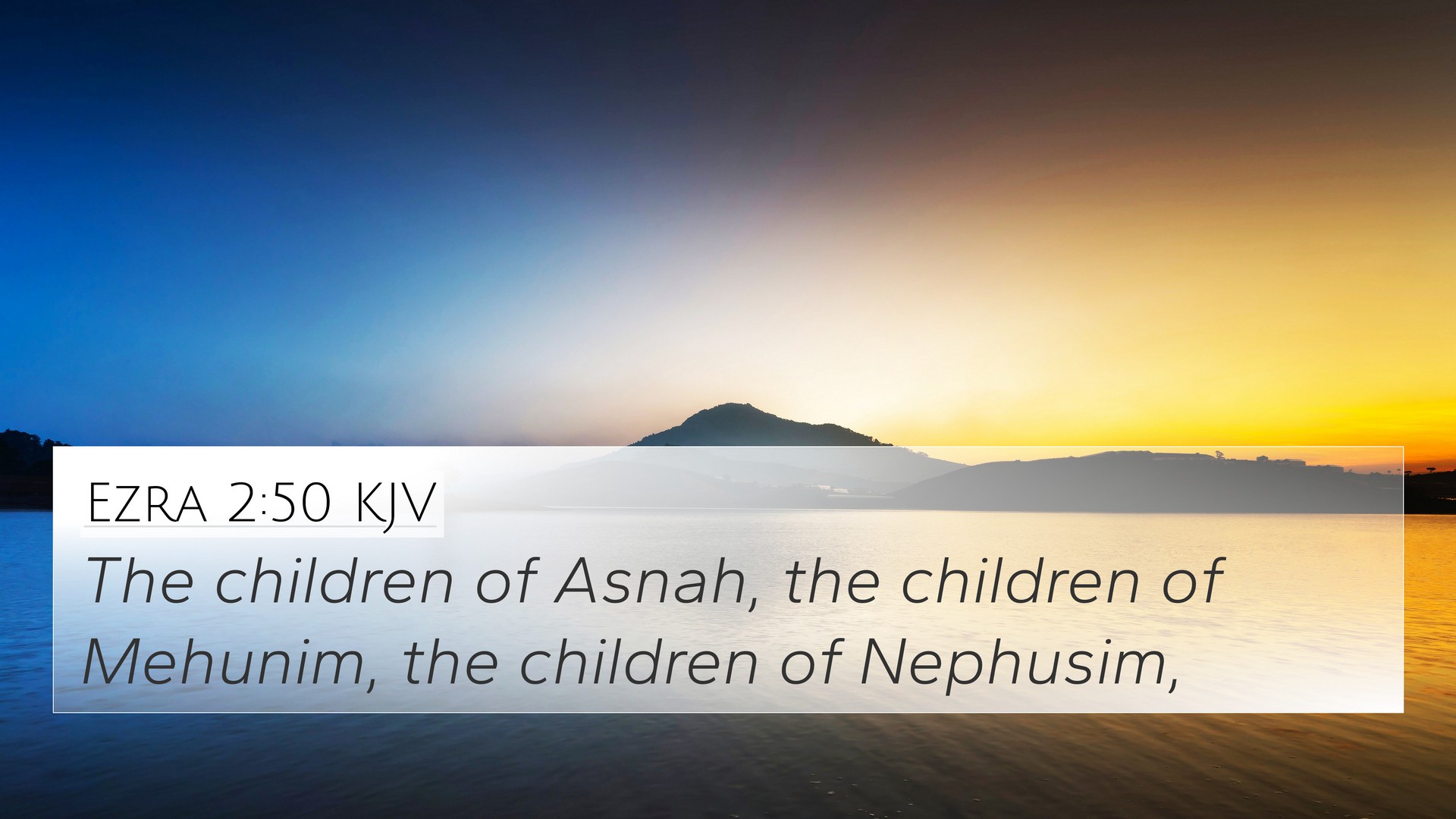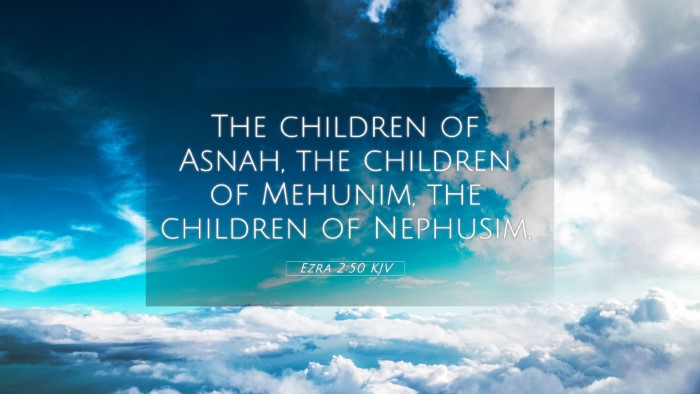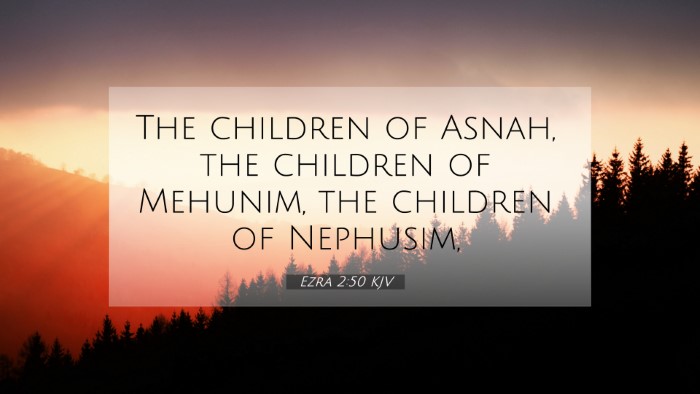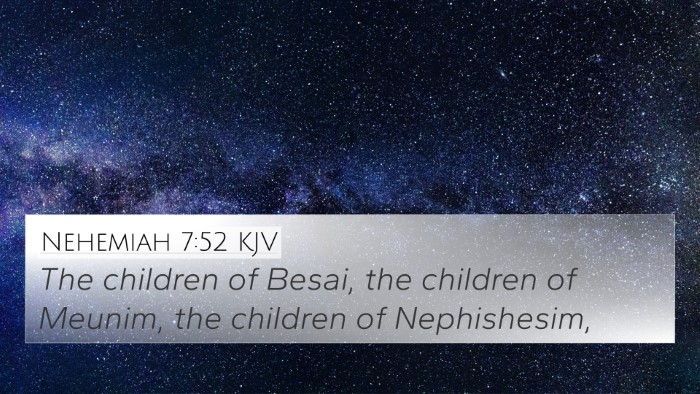Understanding Ezra 2:50
Ezra 2:50 mentions a group known as the "children of Arah," who were among the returning exiles from Babylon to Jerusalem. This verse, while seemingly simple, carries rich implications about the restoration of Israel after the Babylonian captivity.
Context and Significance
The context of Ezra focuses on the return of the Jewish people to their homeland following a period of exile. This particular verse highlights the individuals involved in this significant moment in Jewish history. Matthew Henry notes that the return of these families was not just a physical journey but a spiritual restoration for the nation.
Commentary Insights
-
Matthew Henry's Commentary:
Henry emphasizes that understanding the names and families of those returning sheds light on God's faithfulness to His covenant. The mention of "Arah" connects to larger themes of worship and identity among the Jewish people. The return was a fulfillment of prophecy and a step toward the rebuilding of the temple.
-
Albert Barnes' Notes:
Barnes suggests that this list serves to show the continuity of the Jewish lineage and God's providence. He points out that each name represents a family that maintained a connection to their heritage, emphasizing the importance of community in the rebuilding effort.
-
Adam Clarke's Commentary:
Clarke discusses the genealogical importance of such lists in the Israelite culture. He believes that by referring to the family of Arah, the text stresses the significance of each individual's role in the restoration. They played a part in the greater narrative of God's plan for His people.
Bible Verse Cross-References
The study of Ezra 2:50 can be enriched through comparative analysis with several key verses that connect thematically and contextually:
- Ezra 1:1-4: This passage discusses the decree of Cyrus and the call to rebuild the temple, setting the stage for the return.
- Nehemiah 7:7: This verse includes a similar list of names, showing the intertwining narratives of Ezra and Nehemiah.
- Jeremiah 29:10-14: Here, God promises restoration for the exiles, echoing the themes of hope and return found in Ezra.
- Isaiah 44:28: This verse refers to Cyrus as God's shepherd, linking the prophetic word to its fulfillment in Ezra.
- Haggai 1:2: The call to rebuild the temple reminds readers of the foundational importance of worship in the restoration process.
- Psalms 126:1-3: These verses capture the joy of the returning exiles, providing a poetic reflection on their experiences.
- Malachi 3:6: This verse speaks to God’s unchanging nature, assuring the Israelites, and providing a promise that links to their return.
Connections to Other Biblical Themes
Ezra 2:50 can be analyzed within the broader narrative of restoration and identity in Israel's history. The children of Arah signify not just a return to land but a restoration of God's people. This theme of restoration is echoed throughout the scriptures:
- New Testament Connections: Revelation 21:1-4 describes a new heaven and new earth, echoing themes of restoration and renewal found in Ezra.
- Unity in the Body of Christ: Ephesians 2:19-22 reflects the unity and heritage in Christ, much like the return of Israel to their homeland.
- Redemption and Hope: Romans 8:28 reminds believers of God's purpose in restoration, paralleling the exilic return narrative of Ezra.
Tools for Bible Cross-Referencing
Utilizing tools for cross-referencing can enhance comprehension of contexts like Ezra 2:50. Here are a few resources:
- Bible Concordance: A systematic way to find related verses.
- Bible Cross-Reference Guide: Helps in tracking similar themes across scriptures.
- Cross-Reference Bible Study Methods: Different methodologies can guide deeper exploration and understanding.
Conclusion
Ezra 2:50 is a brief yet profound insight into the divine orchestration of history and the preservation of God's people. By engaging with various public domain commentaries and cross-referencing scripture, readers can appreciate the intricate web of God's plans for His people found within the Bible.
In summary, exploring the meaningful connections between Bible verses enriches our understanding, making scripture come alive as we see the tapestry of God's work across time.



